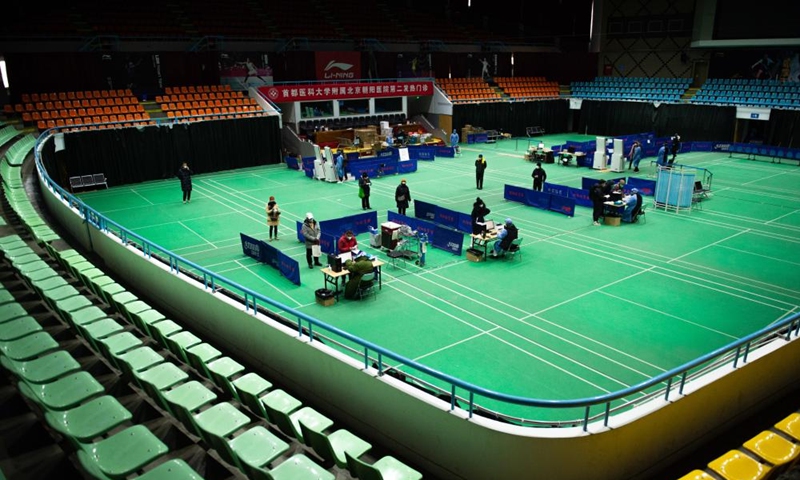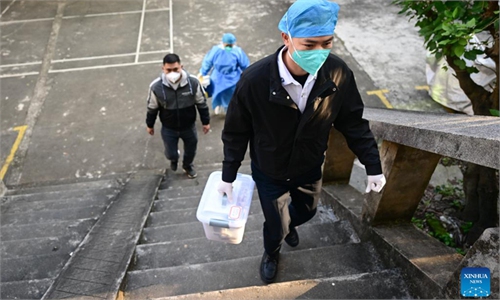
This photo taken on Dec. 24, 2022 shows a makeshift fever clinic of Beijing Chaoyang Hospital in Chaoyang Gymnasium in Beijing, capital of China. In order to facilitate fever patients to seek medical treatment and ensure residents' medical needs, some hospitals in Beijing set up makeshift fever clinics in gymnasiums to provide services such as diagnosis, prescription issuing and medicine dispensing for citizens. (Xinhua/Chen Zhonghao)
China has released a slew of COVID-19 response measures to instruct society and medical institutions to better address the surge of cases and achieve the goal of guaranteeing medical treatment and the prevention of severe cases as the country announced to downgrade COVID-19 management from Class A to Class B since January 8.Newly released measures include the expansion of medical resources and setting up a daily base mobilization mechanism to treat severe cases promptly, as well as conducting epidemic monitoring among key populations, key venues and viral mutation trends.
"The shift is definitely not laissez-faire. We have seen possible risks posed in the early stage of the adjustment of downgrading COVID-19 from Class A to Class B, including surging COVID-19 infections and patients seeking medical treatment and drugs," Liang Wannian, head of the expert panel overseeing the national COVID-19 response, told Tuesday's press conference.
To ensure a smooth transition of handling the downgrading move, the country continues to prepare for possible risks shown in the early stage of policy adjustment. The goal is to maximize meeting medical demand and minimize severe illness and death, Liang noted.
At present, the national resources for patient beds and equipment can meet the needs of severe patients. But efforts to continue to increase surveillance of severe cases in light of the development of the epidemic will be made, and we also called for the establishment of a system of coordinated regional support in the country, Jiao Yahui, an official from the National Health Commission, said during Tuesday's news conference.
China has built a daily-basis mechanism aiming to mobilize resources for treating severe cases to where they are most needed. As of December 25, the total number of ICU beds in China was 181,000, that is, 12.8 for 100,000 people, Jiao Yahui said.
In provinces experiencing the peak of intensive care treatment of severe cases, ICU bed resources are close to the critical value, Jiao noted.
In a bid to receive more cases, severe patients in emergency rooms should be given medical treatment within 24 hours. At the same time, to prevent more severe cases, community health centers have been counting seniors with underlying problems and classifying them in different risk groups, according to Jiao.
Meanwhile, hospitals at or above secondary level and all grassroots medical institutions should open as many fever clinics or consultation rooms as possible. As of December 25, more than 16,000 fever clinics in second-level hospitals and above, and more than 41,000 fever clinics and consultation rooms in community-level health institutions, had been set up, according to Jiao.
In some places, such as Beijing, Shanghai, Anhui, Jiangsu and Shandong provinces, makeshift hospitals, gyms and nucleic acid sampling sites have been converted into temporary fever diagnosis and treatment sites to meet fever patients' demand, Jiao noted.
"Although hospitals now have more COVID-19 patients, we have prepared in an orderly manner," Lu Hongzhou, head of the Third People's Hospital of Shenzhen, told the Global Times on Tuesday. The priority currently is to speed up COVID-19 vaccination among the elderly group and people in rural areas, Lu said.
We did research on the outbreak in this spring in Shanghai and there were relatively fewer severe patients as most of the residents completed the whole process of vaccination at the end of last year, Lu said. The inactivated vaccine protection period is about three to six months, which means that they were mostly protected by vaccines this spring. But facing the upcoming Spring Festival rush, it's preferred to take sequential booster immunization, which uses different types of vaccines, Lu noted.
For people in vulnerable groups, if they were infected by COVID-19, they should take anti-viral small-molecule drugs as soon as possible, as the elderly with underlying diseases can easily develop severe symptoms in the second week, Lu said. "If we can fully prepare for the two steps including speeding up vaccination and using small-molecule drugs promptly, severe and fatal cases will be reduced," Lu said.
Addressing the COVID-19 response in light of downgrading decision, the State Council on Tuesday released five supplementary documents that cover how to monitor the virus and conduct testing.
One of the documents on epidemic monitoring said medical institutions at all levels are required to analyze clinical cases, especially trends linked to severe cases and deaths, and they also must issue diagnostic reports on severe cases and deaths that clearly state the date of discharge and the date and cause of death.
Provincial capitals must select some middle and primary school students in urban areas to carry out sentinel monitoring. The school will monitor symptoms of coronavirus among students on a daily basis, and carry out nucleic acid and antigen tests as needed, the document said. It also requires monitoring sewage in urban locations' sewage treatment plants including the index of the virus gene sequence and viral load to better understand how the virus has changed over times.
Community residents will no longer carry out mass nucleic acid testing and during epidemic periods, each individual will receive a test using an independent tube, according to the document on testing.
If the epidemic is prevalent, measures should be taken to reduce large gatherings, such as commuting at different hours, reducing the frequency of on-site meetings, canceling dine-in services and other measures to reduce the intensity of the epidemic, among other steps in guiding key venues to manage COVID-19, the document reads.



